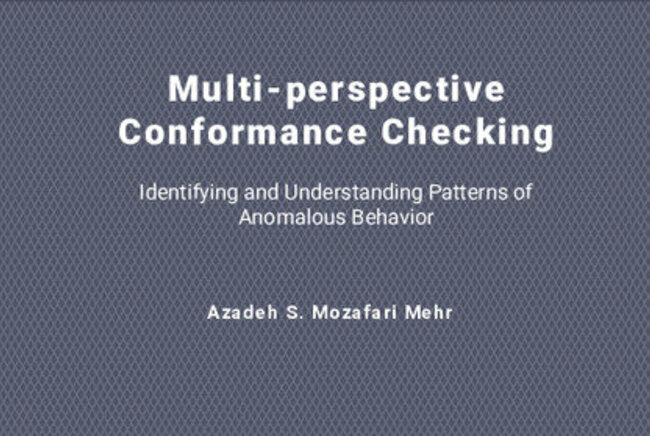Better understanding anomalous behavior through Multi-Perspective Conformance Checking
Azadeh Mozafari Mehr’s work contributes to a more comprehensive and insightful analysis of business process conformance

In modern business, achieving operational excellence, compliance and quality assurance is a key to success. Robust anomaly detection mechanisms are indispensable for this. But existing methods often find it difficult to detect complex anomalies that span multiple perspectives of a business process. There is a clear gap in explaining why certain deviations occur and identifying the elements involved in causing deviations. PhD researcher Azadeh Mozafari Mehr aims to address these challenges by introducing a novel approach to multi-perspective conformance checking. This method focuses on automatically identifying and interpreting patterns of anomalous behavior in the execution of business processes. She defended her thesis on Wednesday May 22nd.

The need for detecting and understanding anomalous behavior
A company runs optimally when its business processes run exactly as they are intended. However, deviations from the norm can always occur. There can be many reasons for this: consider system errors, resource misrepresentations, non-compliance with regulations, or even deliberate fraudulent activities. To maintain control, mitigate risks, and make informed decisions, it is imperative for organizations to spot these deviations and interpret them correctly. Process mining, a family of techniques used to analyze event data in order to understand and improve operational processes, is a powerful tool to help in this regard: by extracting valuable insights from event logs, process mining techniques enable organizations to gain a comprehensive understanding of their processes, identify bottlenecks and uncover inefficiencies. But detecting and interpreting anomalous behavior in business processes is often challenging, and requires a broader approach that takes into account various aspects of a business process and related constraints.
Consider a healthcare organization that follows a standardized patient admission process. This process involves multiple steps, such as patient registration, medical examination, treatment, and discharge. Each step has specific dependencies and requirements, ensuring that patients receive appropriate care. However, in practice, deviations from the expected process can occur. For instance, a medical professional may skip a necessary examination, leading to a delay in diagnosis and treatment. But detecting the anomaly is often not so obvious. Therefore, it is essential to develop a framework that encompasses multiple perspectives and provides explanations for deviations, allowing users to understand the context and reasoning behind the detected anomalies.
A new approach to Multi-Perspective Conformance Checking
To meet these challenges, Azadeh Mozafari Mehr introduces a novel approach to Multi-Perspective Conformance Checking. Her aim is to build a foundation for automatically identifying and interpreting patterns of deviating behavior from multiple perspectives, while explaining these deviations in their respective contexts. By considering the process, data, and privacy perspectives simultaneously, the proposed approach introduces a novel method for computing alignments that captures deviations and provides explanations for the observed behavior. It identifies patterns and respective contexts with reference to the process, data, and organizational models, thereby facilitating a comprehensive understanding of anomalous behavior.
Moving beyond traditional methods
The framework presented by Azadeh Mozafari Mehr goes beyond traditional anomaly detection techniques. First of all, it is capable of detecting anomalies from multiple perspectives in each process instance (case level) and providing insights at the level of the entire process execution (log level). But in addition, it can automate the interpretation of anomalous patterns and categorizing them into roles, users, and system deviating patterns. This framework thereby enhances the understanding of detected anomalies.
Title of PhD thesis: Multi-perspective Conformance Checking: Identifying and Understanding Patterns of Anomalous Behavior
Supervisors: prof.dr.ir. B.F. van Dongen, dr. R. Medeiros de Carvalho
Media contact
More on AI and Data Science
![[Translate to English:] All winners of the 2024 Research Awards. From left to right: Beatrice Federici, Francesca Grisoni, Marc Geers, Vincent Debets, Calum Ryan and Tugce Martagan. Photo: Bart van Overbeeke.](https://assets.w3.tue.nl/w/fileadmin/_processed_/5/1/csm_BvOF%202024_0613_DMH%20TUe%20Research%20Day%20-%20All%20Award%20winners_e4779eae60.jpg)


Latest news
![[Translate to English:] All winners of the 2024 Research Awards. From left to right: Beatrice Federici, Francesca Grisoni, Marc Geers, Vincent Debets, Calum Ryan and Tugce Martagan. Photo: Bart van Overbeeke.](https://assets.w3.tue.nl/w/fileadmin/_processed_/5/1/csm_BvOF%202024_0613_DMH%20TUe%20Research%20Day%20-%20All%20Award%20winners_e4779eae60.jpg)
![[Translate to English:] [Translate to English:]](https://assets.w3.tue.nl/w/fileadmin/_processed_/7/a/csm_image00007_be75479bcc.jpeg)


![[Translate to English:] [Translate to English:]](https://assets.w3.tue.nl/w/fileadmin/_processed_/b/7/csm_DSC02553_76391bbd00.jpg)
